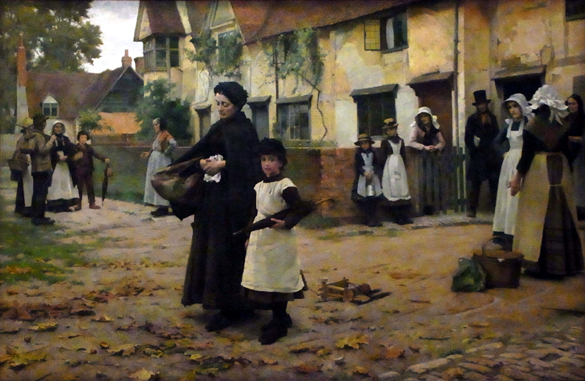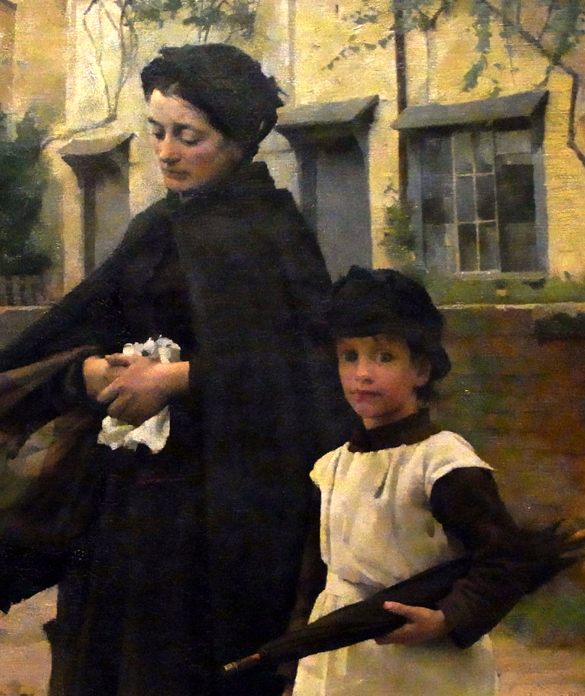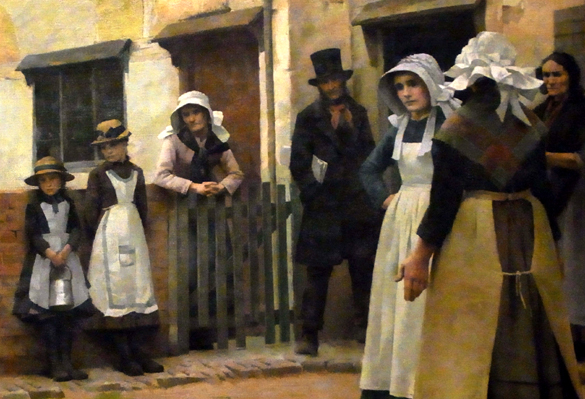
“Evicted” by Blandford Fletcher, 1887 Oil on canvas. Photo taken thanks to Queensland Art Gallery, South Bank, Brisbane, Queensland.
Each visit to the Queensland Art Gallery sees me inexorably drawn to “Evicted” by Blandford Fletcher (1858 -1936). I question why this should be. Is it that this painting from 1887 reminds me of my past life living in English villages, thus stirring emotive memories? Is it that it brings me closer to my ancestors who lived in Britain and would have dressed like this and known the world that it portrays?
What I have no need to question is that it attracts me because it is Beautiful Stuff, masterfully executed by a man who could draw, who understood composition, use of colour and whose immense skill with his chosen medium is undeniable. The subject matter does not attract me as it shows a sad widow and her daughter being evicted from their home in Steventon in Berkshire by the Bailiff with villagers looking on. I wondered why I should like the painting so much when the subject was so tragic. I also wondered why every face had such blandness of expression under the circumstances but concluded that this must be a reflection of the times when to portray high emotion may have appeared almost “cartoony”. Perhaps the artist wished to give the victims dignity and also to not point the finger of blame at the others. In a cruel system all are ultimately victims I suppose. But that is conjecture. On my last visit to the painting I was unconvinced by the above conclusions as I felt that the full reason for its fascination still eluded me. I read the information plaque again and I then understood. ‘….Fletcher’s interests lay less in landscapes than in the human stories associated with English village life. His paintings typified late Victorian works that appealed to the social conscience in an age of rapid industrialisation, reform and economic hardship.’
The words ‘appealed to the social conscience’ were the key. This was the missing layer, the hidden extra, the further dimension that this painting offered. It was painted for a reason above and beyond the artist’s need to recreate that which appealed to his aesthetic senses. It was a statement designed to initiate change and I saw parallels with the songs of John Lennon, the writings of Harriet Beecher Stowe and all the works of ‘artists’ throughout the ages who have highlighted the suffering and injustices in society and on occasions offered solutions. This made me further think about the ‘artist’s’ role in initiating social change. I feel that simply because of what artists do their views in this arena are seen and heard most readily, stridently and often in extraordinarily attractive and powerful ways. This, I think, has resulted in society giving an unjustified importance to artists’ opinions and therefore granting them a licence, bordering on a monopoly, over the regulation of the social conscience. If this is true then it is a complete fallacy. We all must be and can be guardians of the social conscience and initiate social change by using whatever medium we are skilled at using.


